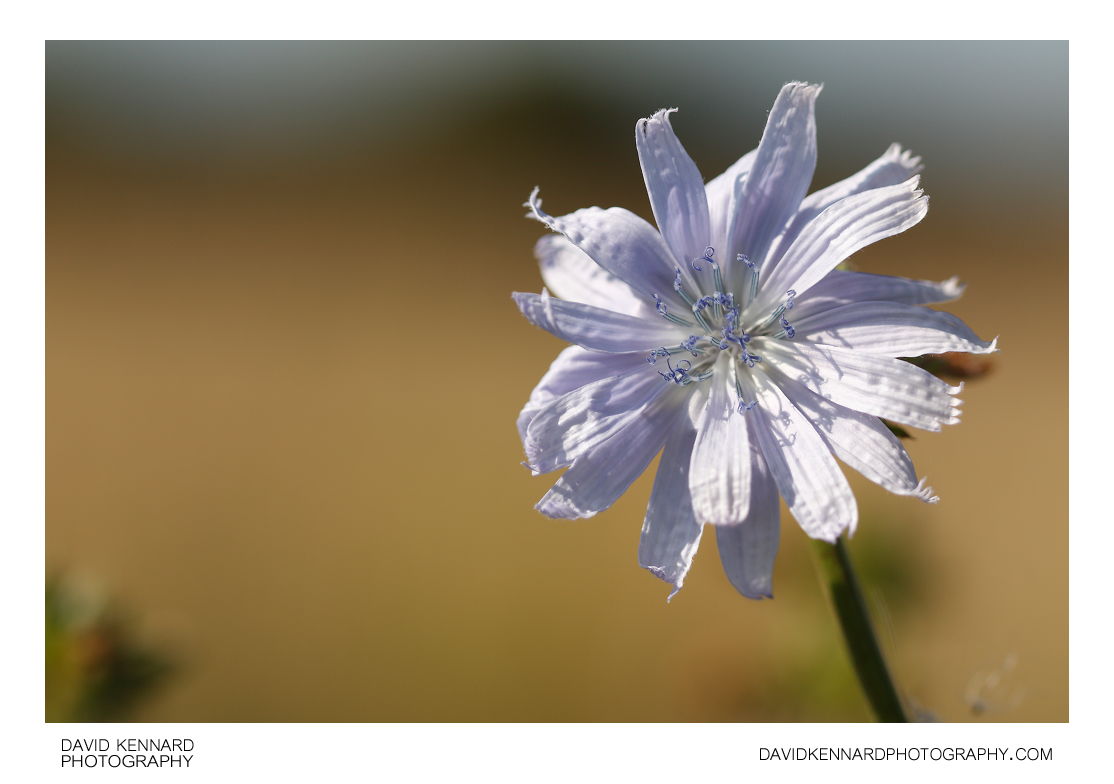Common chicory (Cichorium intybus) flower

Description
- Title:
- Common chicory (Cichorium intybus) flower
- Caption / Description:
-
Common chicory, Cichorium intybus, is a somewhat woody, perennial herbaceous plant usually with bright blue flowers, rarely white or pink. Various varieties are cultivated for salad leaves, chicons (blanched buds), or for roots (var. sativum), which are baked, ground, and used as a coffee substitute and additive. It is also grown as a forage crop for livestock.
It lives as a wild plant on roadsides in its native Europe, and in North America and Australia, where it has become naturalized.
When flowering, chicory has a tough, grooved, and more or less hairy stem, from 30 to 100 centimetres (10 to 40 in) tall.
The leaves are stalked, lanceolate and unlobed.The flower heads are 2 to 4 centimetres (0.79 to 1.6 in) wide, and usually bright blue, rarely white or pink. There are two rows of involucral bracts; the inner are longer and erect, the outer are shorter and spreading. It flowers from July until October.
Description adapted from Wikipedia: http://en.wikipedia.org/wiki/Chicory
- Tags / Keywords:
-
- Biota
- Life
- Vitae
- Eukaryota
- Plantae
- Plants
- Magnoliophyta
- Flowering Plants
- Angiosperms
- Magnoliopsida
- Dicotyledons
- Asteraceae
- Asterales
- Asters
- Compositae
- Daisies
- Sunflowers
- Cichorium
- Chicory
- Endive
- Cichorium intybus
- Common chicory
- Blue flower
- Purple flower
- Chicory flower
Admin
- Date Original Photo Taken:
- Original File Name:
- _MG_8762.CR2
- Event:
- Rating:
- ☆
- Date this image added/last updated on website:
- Original File Dimensions:
- 4272px x 2848px
- File Type:
- JPEG
- Color Mode:
- Original Image Color Profile:
- Adobe RGB (1998)
Location
- Location Created:
-
- Sublocation:
- City:
- Marston Trussell
- Province/State:
- Northamptonshire
- Country:
- United Kingdom
- World Region:
- Europe
- Geo-location:
- 52.462775, -0.973805 View on map
Rights
- Copyright Status:
- Copyrighted
- Licensing Status:
- Rights Managed
- Available for Editorial Use:
- Yes
- Available for Commercial Use:
- Yes
- Copyright Notice:
- © 2011 Dave Kennard
Camera Data
- Date Digital Resource was created:
- Shutter speed:
- 1⁄1000 s
- Aperture:
- f/3.5
- Camera Model:
- Canon EOS 450D
- ISO:
- 100
- Exposure Compensation:
- 0
- Focal Length:
- 100mm
- Focal Length (35mm equiv.):
- Metering Mode:
- Flash:
- Off, Did not fire
- Exposure Mode:
- Auto
- White Balance:
- Manual
- Light Source:
- Exposure Program:
Additional shooting metadata
- Lens:
- Canon EF 100mm F2.8 Macro USM
- Filters used:
- Additional Optics used:
- Setup:
- Handheld
Liveview using Perfect LCD Viewfinder
Post Processing
- Image Modified:
- Software used:
-
- Canon Digital Photo Professional (DPP) 3.10
- Post Processing:
White balance adjusted in DPP
